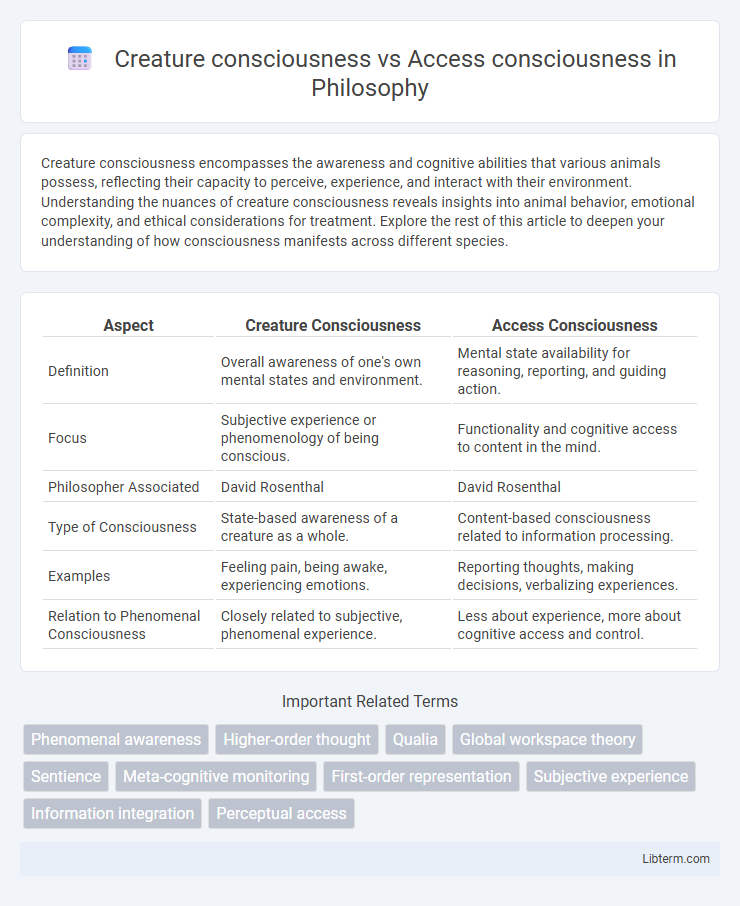Creature consciousness encompasses the awareness and cognitive abilities that various animals possess, reflecting their capacity to perceive, experience, and interact with their environment. Understanding the nuances of creature consciousness reveals insights into animal behavior, emotional complexity, and ethical considerations for treatment. Explore the rest of this article to deepen your understanding of how consciousness manifests across different species.
Table of Comparison
| Aspect | Creature Consciousness | Access Consciousness |
|---|---|---|
| Definition | Overall awareness of one's own mental states and environment. | Mental state availability for reasoning, reporting, and guiding action. |
| Focus | Subjective experience or phenomenology of being conscious. | Functionality and cognitive access to content in the mind. |
| Philosopher Associated | David Rosenthal | David Rosenthal |
| Type of Consciousness | State-based awareness of a creature as a whole. | Content-based consciousness related to information processing. |
| Examples | Feeling pain, being awake, experiencing emotions. | Reporting thoughts, making decisions, verbalizing experiences. |
| Relation to Phenomenal Consciousness | Closely related to subjective, phenomenal experience. | Less about experience, more about cognitive access and control. |
Defining Creature Consciousness
Creature consciousness refers to the overall awareness that an organism possesses as a whole, encompassing its ability to have subjective experiences and sensations without necessarily being able to report or access these experiences explicitly. This form of consciousness involves basic sentience and the organism's responsiveness to stimuli, reflecting a fundamental level of perceptual awareness. It contrasts with access consciousness, which involves the explicit availability of information for reasoning, verbal report, and decision-making processes.
Understanding Access Consciousness
Access consciousness refers to the cognitive availability of information for reasoning, verbal report, and deliberate action, distinct from creature consciousness which denotes a general state of wakefulness and responsiveness. It involves the integration of sensory inputs into a coherent experience that can be manipulated by cognitive processes such as decision-making and problem-solving. Understanding access consciousness emphasizes its role in enabling intentional behavior through the global availability of mental content within the brain's working memory system.
Key Differences Between Creature and Access Consciousness
Creature consciousness refers to the overall experiential state of an organism, encompassing its capacity to have subjective experiences and feelings. Access consciousness involves the availability of specific information for verbal report, reasoning, and guiding behavior, highlighting cognitive access rather than mere experience. Key differences lie in that creature consciousness captures the qualitative phenomenology of being conscious, while access consciousness emphasizes the functional aspects of information processing and use within the cognitive system.
Historical Perspectives on Consciousness
Historical perspectives on consciousness distinguish between creature consciousness, referring to an organism's overall ability to experience states, and access consciousness, which involves the availability of information for reasoning and behavior control. Philosophers like Ned Block have emphasized this dichotomy to clarify debates on subjective experience versus cognitive access in the philosophy of mind. Early theories by William James and later developments in cognitive science laid the groundwork for understanding these distinct but overlapping dimensions of consciousness.
Neuroscientific Basis of Creature Consciousness
Creature consciousness refers to the overall state of awareness an organism possesses, encompassing subjective experience and wakefulness, and is primarily associated with neural activity in the brainstem and thalamocortical networks. Neuroscientific studies highlight the role of the reticular activating system in regulating arousal levels critical for creature consciousness, while cortical regions contribute to the integration of sensory input that underpins this global state. Functional imaging and electrophysiological data reveal that disruptions in these subcortical and cortical interactions result in altered or diminished creature consciousness, distinguishing it from access consciousness, which relates more to the availability of information for cognitive processing.
Cognitive Mechanisms in Access Consciousness
Access consciousness involves cognitive mechanisms that enable information to be globally available for reasoning, decision-making, and verbal report, highlighting processes like working memory, attention control, and executive functions. These mechanisms facilitate the integration and manipulation of sensory data, supporting flexible behavior and goal-directed activity. Creature consciousness, in contrast, pertains to an organism's overall awareness without requiring such complex information access or cognitive manipulation.
Creature Consciousness in Non-Human Animals
Creature consciousness in non-human animals refers to the raw experiential awareness or phenomenological state that enables them to feel sensations such as pain, pleasure, and emotions. Neuroscientific studies demonstrate that many species possess neural substrates--such as the thalamocortical complex or analogous structures--that support this form of consciousness, distinct from higher-order cognition associated with access consciousness. Ethological evidence highlights behaviors indicative of creature consciousness, including responses to environmental stimuli and social interactions, underscoring the capacity for subjective experience across diverse taxa.
Access Consciousness and Human Cognition
Access consciousness refers to the cognitive ability to access and report information available for reasoning, decision-making, and guiding behavior, playing a crucial role in human cognition. It enables humans to manipulate and integrate sensory data, memories, and thoughts to perform complex tasks such as problem-solving and language comprehension. Unlike creature consciousness, which is a broad awareness of stimuli, access consciousness specifically involves the neural mechanisms that allow information to be utilized consciously in goal-directed actions.
Implications for Artificial Intelligence
Creature consciousness entails the overall subjective experience or sentience of an entity, while access consciousness involves the availability of information for reasoning and guiding behavior. In artificial intelligence, privileging access consciousness allows systems to process, report, and act on data without possessing subjective experience, which challenges the development of genuinely sentient AI. Understanding this distinction informs ethical considerations and the design of AI architectures that simulate awareness without necessitating true phenomenal consciousness.
Future Directions in Consciousness Research
Future directions in consciousness research emphasize distinguishing between creature consciousness--overall awareness at the organism level--and access consciousness, which involves the availability of information for reasoning and behavior. Advances in neuroimaging and computational modeling aim to map the neural correlates specific to each type, enhancing understanding of their functional distinctions. Integrating interdisciplinary approaches, including AI and cognitive neuroscience, will drive novel methodologies to probe subjective experience and informational accessibility in both humans and non-human animals.
Creature consciousness Infographic

 libterm.com
libterm.com